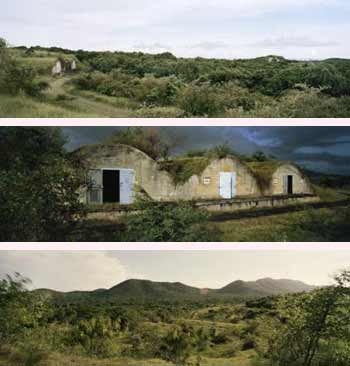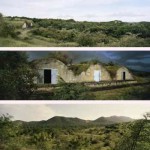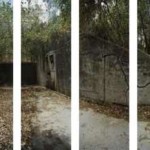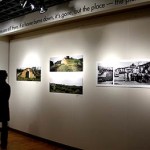By HEIDI AISHMAN
Vieques: A Long Way Home, Bonnie Donohue's exhibit at Casa de la Cultura, consists of several multi-paneled photographs and panorama's of the U.S. Navy bunkers embedded in the landscape of the island of Vieques. Vieques is a small island off the coast of Puerto Rico, a protectorate of the U.S. These photographs visually represent the how the troubled relationship between the Navy and the inhabitants of Vieques will never be forgotten. Though the occupation of the U.S. Navy is over, hidden bunkers, overgrown with tress and grass, scar the landscape. They will not degrade over time, they are not going to be dismantled, or dug up; they are entrenched within the land as a constant reminder of the destruction of the economy and ecology on Vieques.
When I heard about Donohue's exhibit at Casa de la Cultura, all I knew about Vieques was that a friend of mine went on vacation there once. When I did a Google search for the history of Vieques a blank page came up that had only two lines:
1. Brief history of Vieques and
2. History of the Navy in Vieques
When the Navy arrived in 1941, there were 10,362 inhabitants in Vieques and 8,000 tons of sugar was produced that year. The Navy expropriated two thirds of the total land, including most of the land used for farming. During the first couple of years after the Navy arrived, there were plenty of jobs in Vieques in the construction of the bases. People came from Puerto Rico and the Virgin Islands to work in Vieques. When construction was over the workers left. When the dust had settled, 3,000 of the 9,000 inhabitants of Vieques had been relocated to St. Croix. There was no sugar and no base construction left to do. The government of Puerto Rico tried, between 1945 and the 1960's, to re-establish an agricultural economy in what was left of the civilian section of Vieques but failed. Between 1960 and 1970 the economy shifted from agriculture to manufacture, being the General Electric plant the most consistent source of employment. The plant was established in 1969 and is still in operation.
The population in Vieques has not changed much through the decades and still remains close to 10,000. Unemployment runs high. College bound kids seldom come back to live in Vieques but you can usually find them visiting the Island around summer. At the present time there is some development of the tourism industry. Many residents make a living out of renting their properties to tourists. This new industry has brought along a new influx of residents from the continental U.S.A.
Development of any kind has been seriously limited as long as the Navy remained in control of two thirds of the total Island. People have protested the bombing of the beaches beyond tourist's reach, the consequences to the ecology and the health of the population, the destruction of archaeological sites, and the restricted access to the beautiful resources on the bases.
Donohue has made several bodies of work that have given me new perspectives on other social injustices in places like South Africa and Belfast, Ireland. In her new work Vieques: A Long Way Home, Donohue shows a view of the Naval occupation in Vieques that we would not have the opportunity to see now that the occupation is over. By exhibiting this series in Casa de la Cultura's gallery space, it takes on a very different meaning than if it had been exhibited in a formal gallery setting. The Center for Latino Arts are not only exhibiting the work, they also had a panel discussion on the current social climate in Vieques and the impact of the arts on the community. This exhibit touches on not only the importance of seeing Donohue's work, but also seeing it in context. In context to history, to time and place and to what happens now in an area that has struggled with occupation by its own country.
In October 19, 1999, Gov. Pedro Roselló released a history about the history of the Navy Navy in Vieques:
"Never again shall we tolerate abuse of a magnitude and scope the likes of which no community in any of the fifty states would ever be asked to tolerate. Never again shall we tolerate such abuse: not for sixty years, and not for sixty months, or sixty hours, or sixty minutes."
The work of Bonnie Donohue shows us that both the history before the occupation and after remains and both are important to the people of Vieques. On the wall above several of her photographs is a quote by Toni Morrison:
"Places, places are still there. If a house burns down it is gone, but the place, the picture of it stays, and not just in my memory, but out there in the world."
- Bonnie Donohue, three images from Vieques: A Long Way Home
- Bonnie Donohue, from Vieques: A Long Way Home
- Bonnie Donohue, Vieques: A Long Way Home, installation view.
Casa de la Cultura/Center for Latino Arts
"Vieques: A Long Way Home" by photographer Bonnie Donohue is on view June 14 - July 27 at Casa de la Cultura.
All images are courtesy of the artist and Casa de la Cultura.
For more information on Vieques, try BRIEF HISTORY OF VIEQUES by Wanda Bermúdez, 1998.







